Abstract
Pathways for the degradation of 3,5-dimethyl-4-hydroxy-azobenzene-4'-sulfonic acid (I) and 3-methoxy-4-hydroxyazobenzene-4'-sulfonamide (II) by the manganese peroxidase and ligninase of Phanerochaete chrysosporium and by the peroxidase of Streptomyces chromofuscus have been proposed. Twelve metabolic products were found, and their mechanisms of formation were explained. Preliminary oxidative activation of the dyes resulted in the formation of cationic species, making the molecules vulnerable to the nucleophilic attack of water. Two types of hydrolytic cleavage were observed. Asymmetric splitting gave rise to quinone and diazene derivatives, while symmetric splitting resulted in the formation of quinone monoimine and nitroso derivatives. These unstable intermediates underwent further redox, oxidation, and hydrolytic transformation, eventually furnishing 11 organic products and ammonia.
Full text
PDF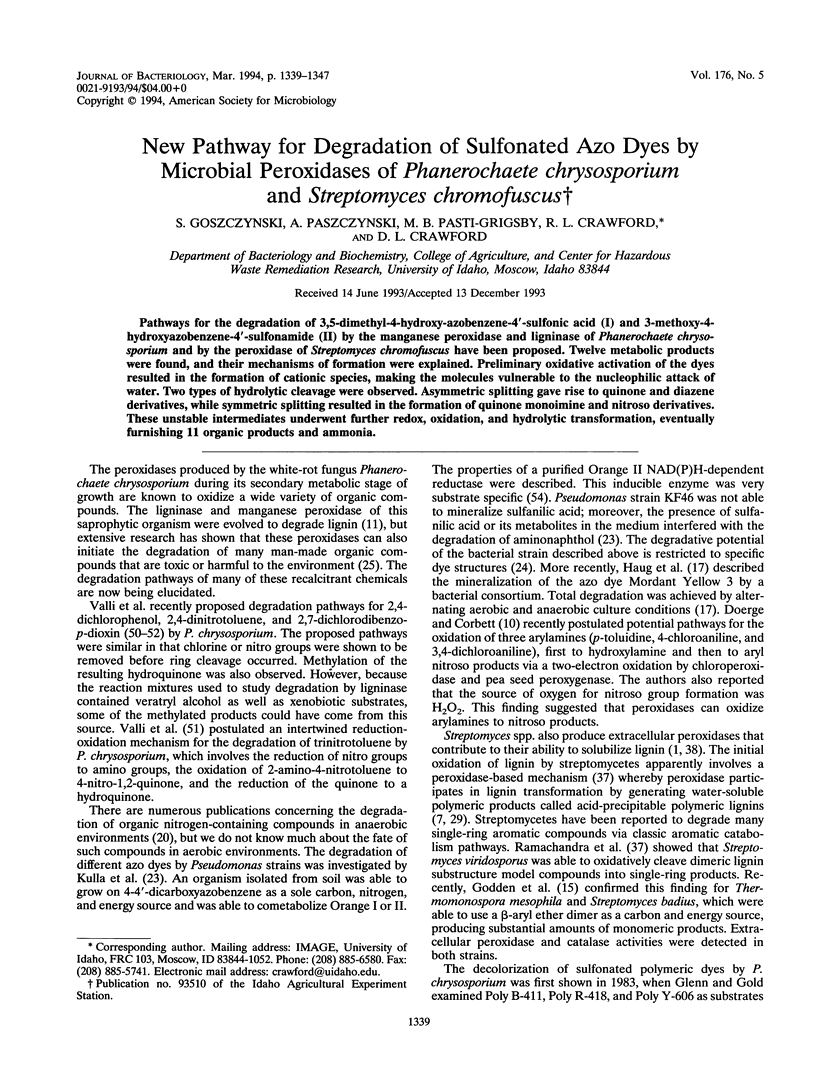
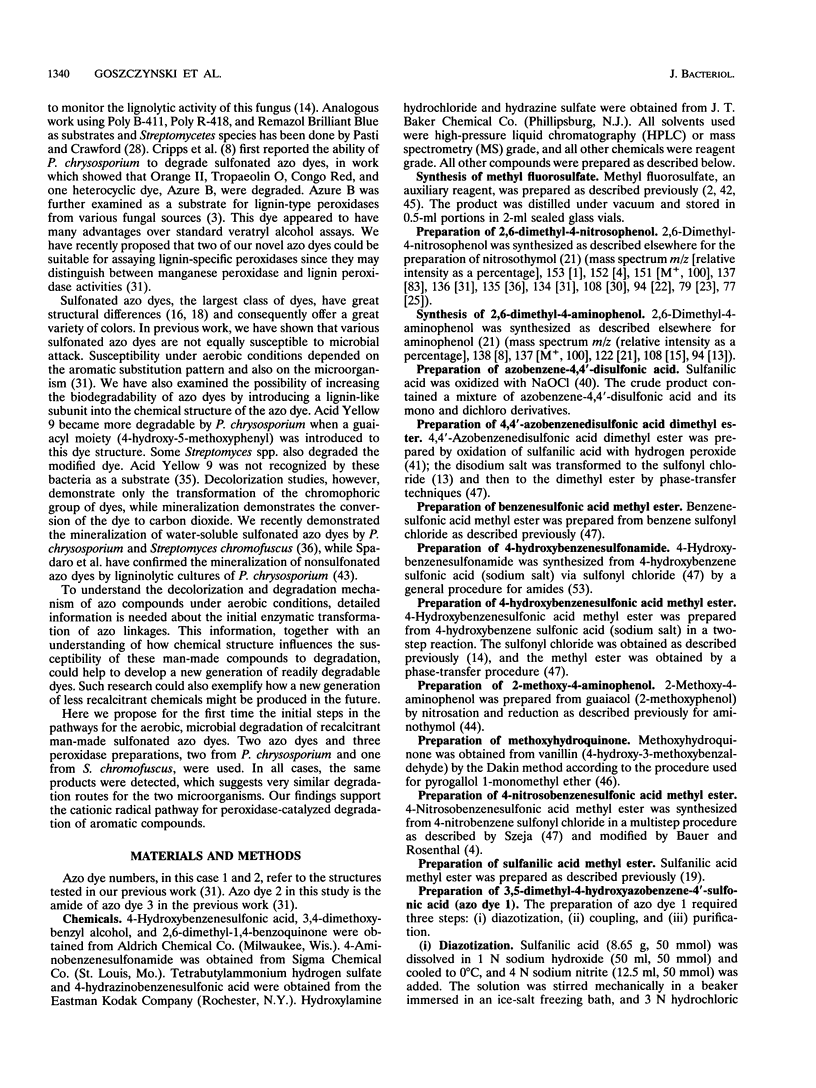
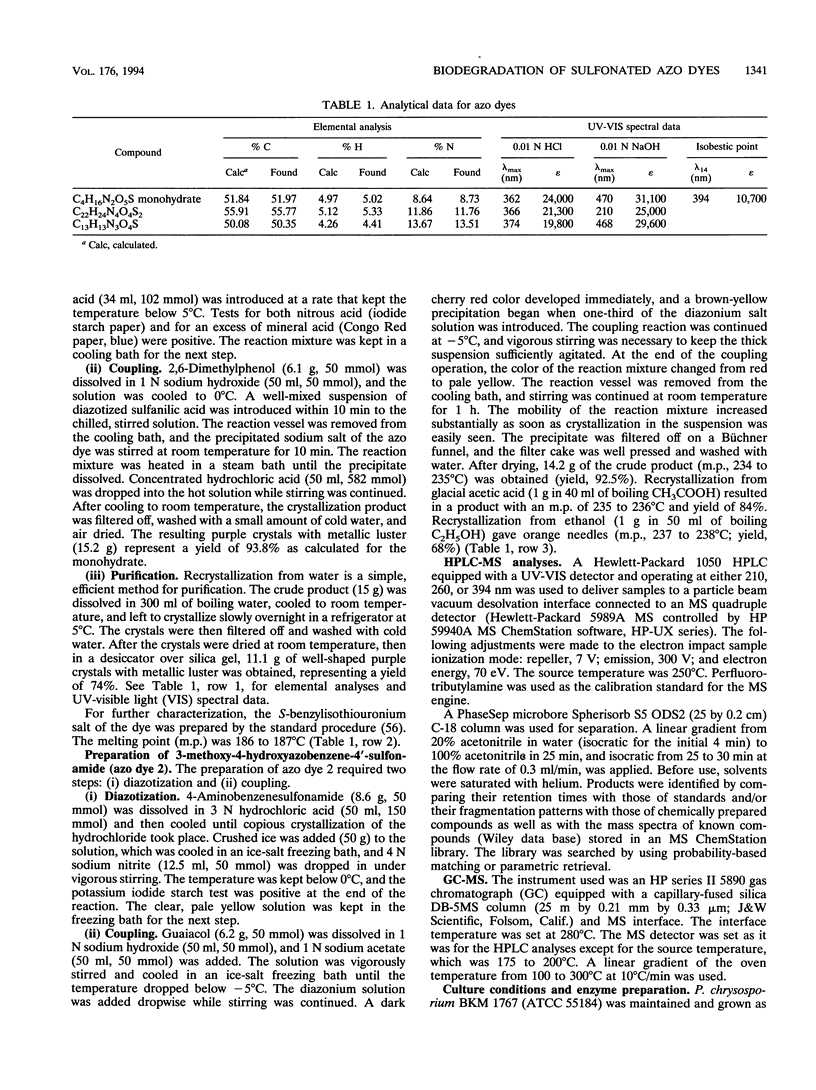
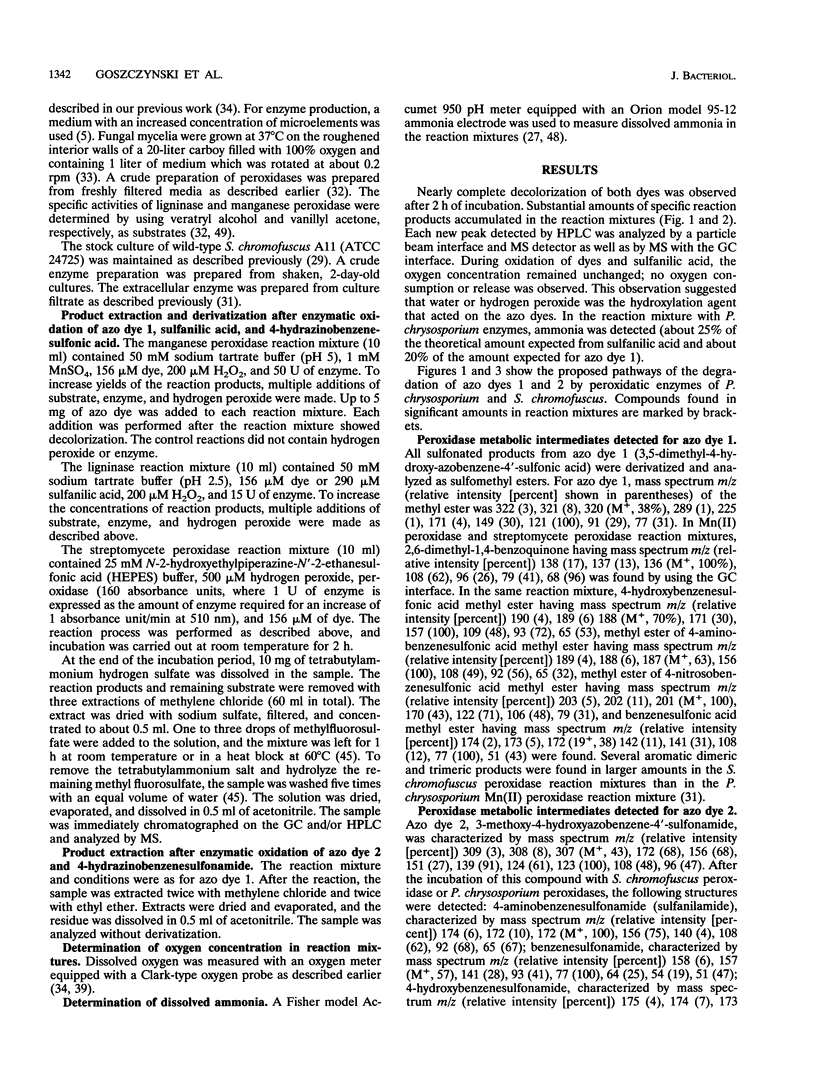
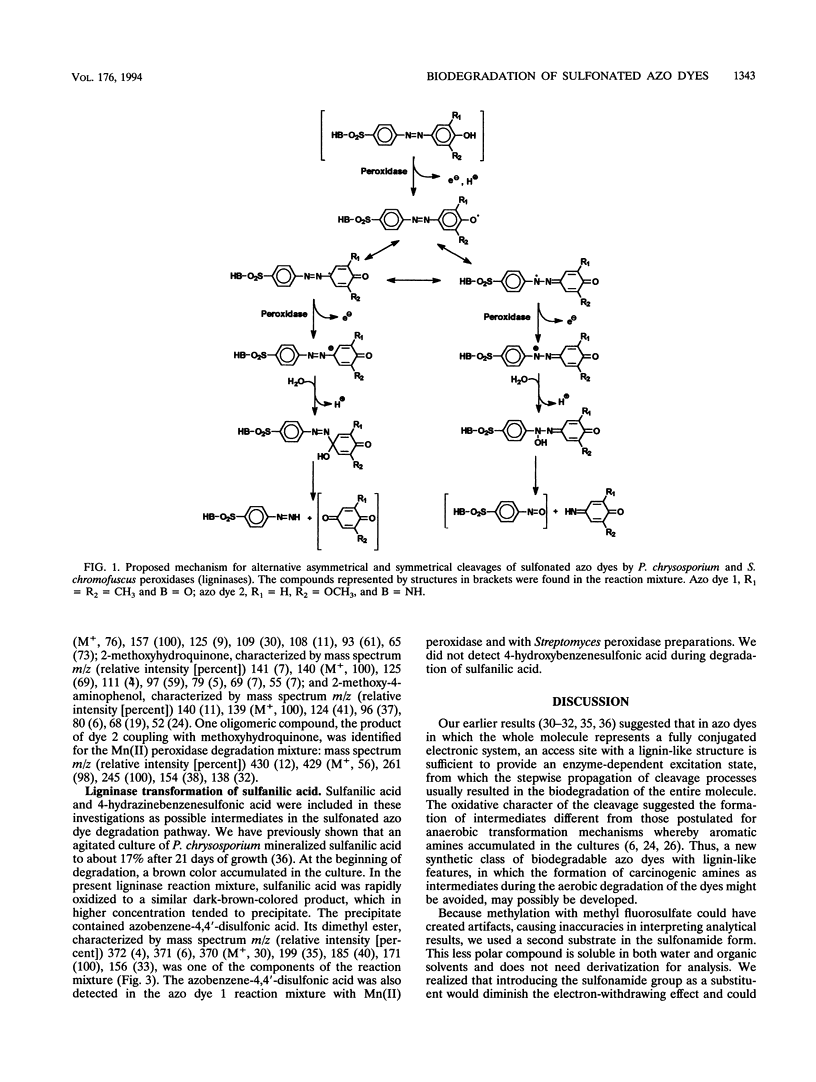
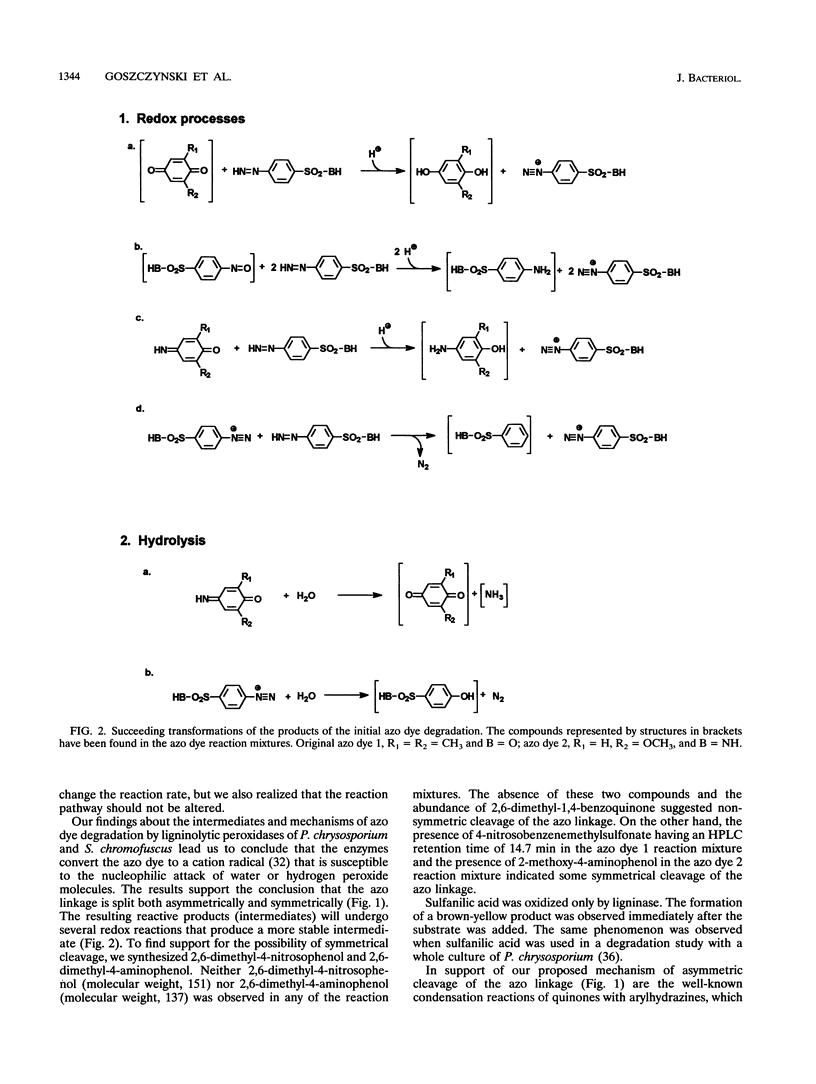
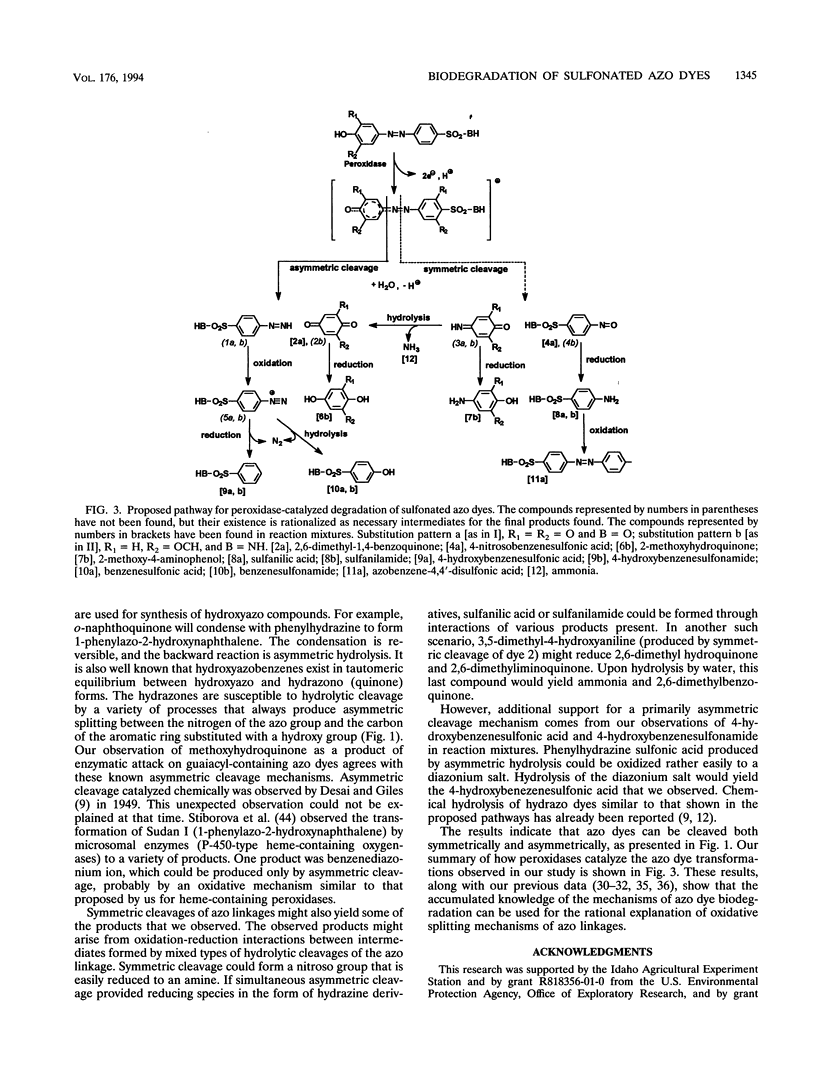
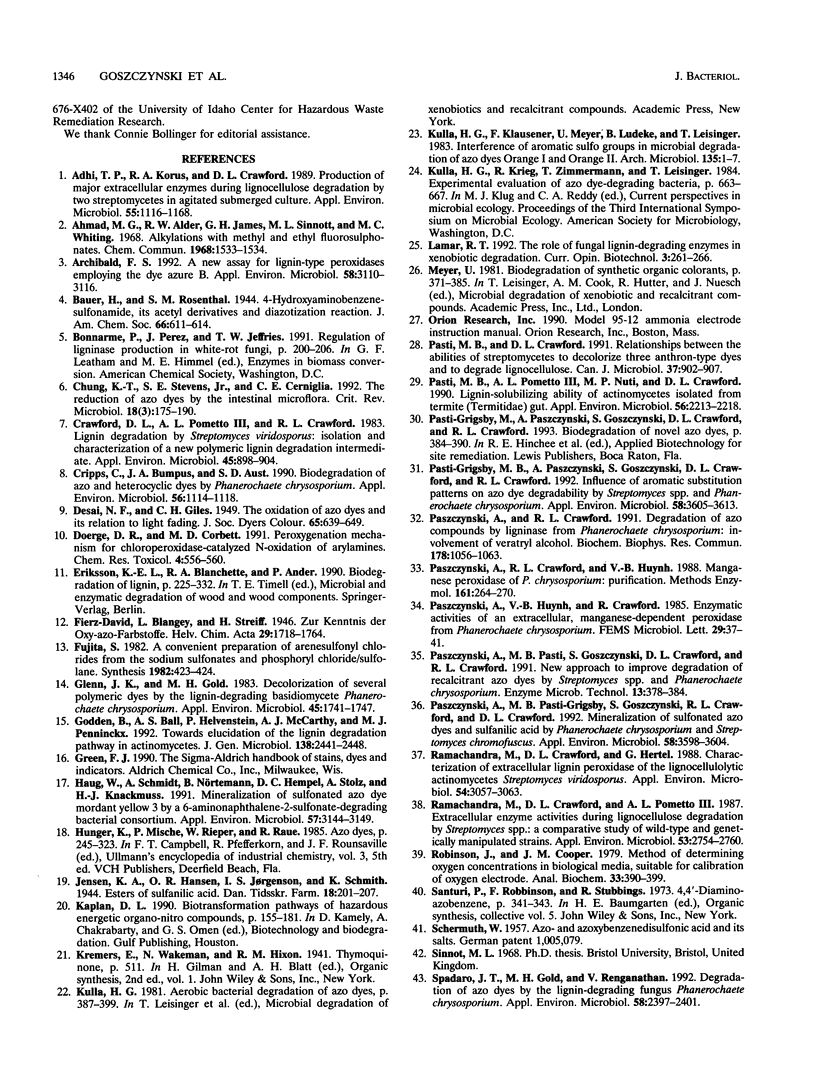
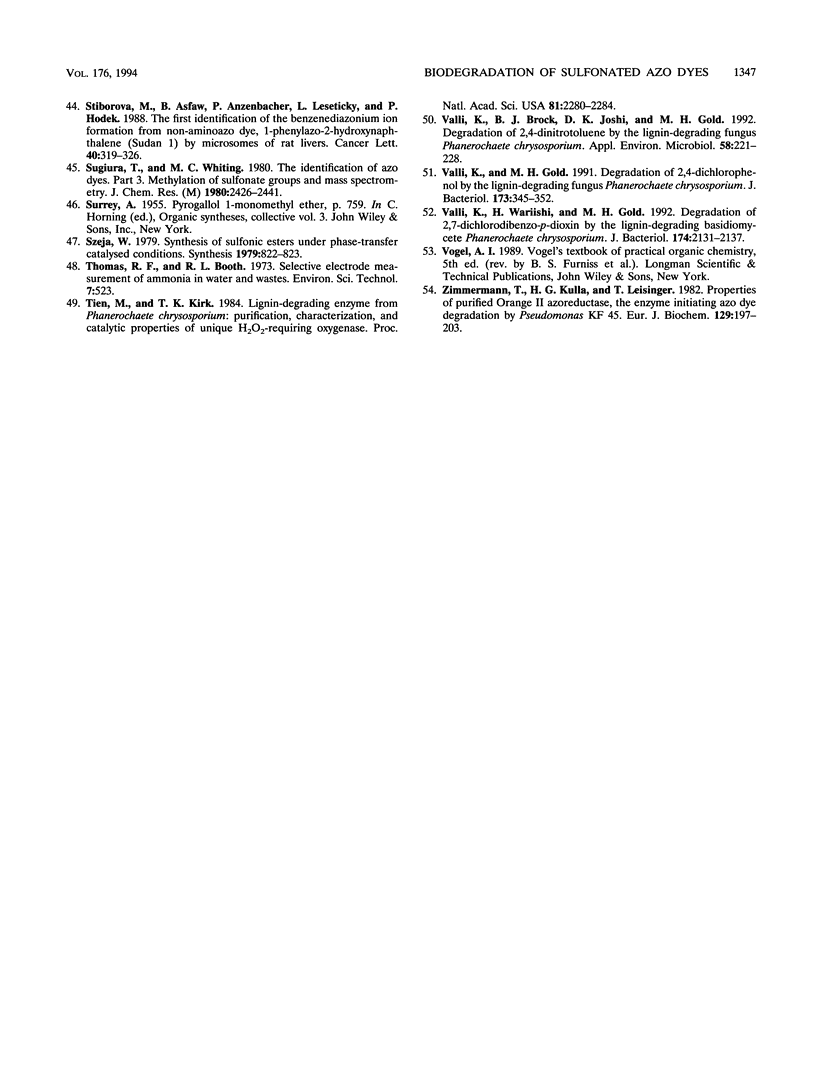
Selected References
These references are in PubMed. This may not be the complete list of references from this article.
- Adhi T. P., Korus R. A., Crawford D. L. Production of Major Extracellular Enzymes during Lignocellulose Degradation by Two Streptomycetes in Agitated Submerged Culture. Appl Environ Microbiol. 1989 May;55(5):1165–1168. doi: 10.1128/aem.55.5.1165-1168.1989. [DOI] [PMC free article] [PubMed] [Google Scholar]
- Archibald F. S. A new assay for lignin-type peroxidases employing the dye azure B. Appl Environ Microbiol. 1992 Sep;58(9):3110–3116. doi: 10.1128/aem.58.9.3110-3116.1992. [DOI] [PMC free article] [PubMed] [Google Scholar]
- Chung K. T., Stevens S. E., Jr, Cerniglia C. E. The reduction of azo dyes by the intestinal microflora. Crit Rev Microbiol. 1992;18(3):175–190. doi: 10.3109/10408419209114557. [DOI] [PubMed] [Google Scholar]
- Crawford D. L., Pometto A. L., Crawford R. L. Lignin Degradation by Streptomyces viridosporus: Isolation and Characterization of a New Polymeric Lignin Degradation Intermediate. Appl Environ Microbiol. 1983 Mar;45(3):898–904. doi: 10.1128/aem.45.3.898-904.1983. [DOI] [PMC free article] [PubMed] [Google Scholar]
- Cripps C., Bumpus J. A., Aust S. D. Biodegradation of azo and heterocyclic dyes by Phanerochaete chrysosporium. Appl Environ Microbiol. 1990 Apr;56(4):1114–1118. doi: 10.1128/aem.56.4.1114-1118.1990. [DOI] [PMC free article] [PubMed] [Google Scholar]
- Doerge D. R., Corbett M. D. Peroxygenation mechanism for chloroperoxidase-catalyzed N-oxidation of arylamines. Chem Res Toxicol. 1991 Sep-Oct;4(5):556–560. doi: 10.1021/tx00023a011. [DOI] [PubMed] [Google Scholar]
- Glenn J. K., Gold M. H. Decolorization of Several Polymeric Dyes by the Lignin-Degrading Basidiomycete Phanerochaete chrysosporium. Appl Environ Microbiol. 1983 Jun;45(6):1741–1747. doi: 10.1128/aem.45.6.1741-1747.1983. [DOI] [PMC free article] [PubMed] [Google Scholar]
- Haug W., Schmidt A., Nörtemann B., Hempel D. C., Stolz A., Knackmuss H. J. Mineralization of the sulfonated azo dye Mordant Yellow 3 by a 6-aminonaphthalene-2-sulfonate-degrading bacterial consortium. Appl Environ Microbiol. 1991 Nov;57(11):3144–3149. doi: 10.1128/aem.57.11.3144-3149.1991. [DOI] [PMC free article] [PubMed] [Google Scholar]
- Pasti-Grigsby M. B., Paszczynski A., Goszczynski S., Crawford D. L., Crawford R. L. Influence of aromatic substitution patterns on azo dye degradability by Streptomyces spp. and Phanerochaete chrysosporium. Appl Environ Microbiol. 1992 Nov;58(11):3605–3613. doi: 10.1128/aem.58.11.3605-3613.1992. [DOI] [PMC free article] [PubMed] [Google Scholar]
- Pasti M. B., Pometto A. L., 3rd, Nuti M. P., Crawford D. L. Lignin-solubilizing ability of actinomycetes isolated from termite (Termitidae) gut. Appl Environ Microbiol. 1990 Jul;56(7):2213–2218. doi: 10.1128/aem.56.7.2213-2218.1990. [DOI] [PMC free article] [PubMed] [Google Scholar]
- Paszczynski A., Crawford R. L. Degradation of azo compounds by ligninase from Phanerochaete chrysosporium: involvement of veratryl alcohol. Biochem Biophys Res Commun. 1991 Aug 15;178(3):1056–1063. doi: 10.1016/0006-291x(91)90999-n. [DOI] [PubMed] [Google Scholar]
- Paszczynski A., Pasti-Grigsby M. B., Goszczynski S., Crawford R. L., Crawford D. L. Mineralization of sulfonated azo dyes and sulfanilic acid by Phanerochaete chrysosporium and Streptomyces chromofuscus. Appl Environ Microbiol. 1992 Nov;58(11):3598–3604. doi: 10.1128/aem.58.11.3598-3604.1992. [DOI] [PMC free article] [PubMed] [Google Scholar]
- Ramachandra M., Crawford D. L., Hertel G. Characterization of an extracellular lignin peroxidase of the lignocellulolytic actinomycete Streptomyces viridosporus. Appl Environ Microbiol. 1988 Dec;54(12):3057–3063. doi: 10.1128/aem.54.12.3057-3063.1988. [DOI] [PMC free article] [PubMed] [Google Scholar]
- Ramachandra M., Crawford D. L., Pometto A. L. Extracellular Enzyme Activities during Lignocellulose Degradation by Streptomyces spp.: A Comparative Study of Wild-Type and Genetically Manipulated Strains. Appl Environ Microbiol. 1987 Dec;53(12):2754–2760. doi: 10.1128/aem.53.12.2754-2760.1987. [DOI] [PMC free article] [PubMed] [Google Scholar]
- Robinson J., Cooper J. M. Method of determining oxygen concentrations in biological media, suitable for calibration of the oxygen electrode. Anal Biochem. 1970 Feb;33(2):390–399. doi: 10.1016/0003-2697(70)90310-6. [DOI] [PubMed] [Google Scholar]
- Spadaro J. T., Gold M. H., Renganathan V. Degradation of azo dyes by the lignin-degrading fungus Phanerochaete chrysosporium. Appl Environ Microbiol. 1992 Aug;58(8):2397–2401. doi: 10.1128/aem.58.8.2397-2401.1992. [DOI] [PMC free article] [PubMed] [Google Scholar]
- Stiborová M., Asfaw B., Anzenbacher P., Leseticky L., Hodek P. The first identification of the benzenediazonium ion formation from a non-aminoazo dye, 1-phenylazo-2-hydroxynaphthalene (Sudan I) by microsomes of rat livers. Cancer Lett. 1988 Jun 30;40(3):319–326. doi: 10.1016/0304-3835(88)90091-2. [DOI] [PubMed] [Google Scholar]
- Tien M., Kirk T. K. Lignin-degrading enzyme from Phanerochaete chrysosporium: Purification, characterization, and catalytic properties of a unique H(2)O(2)-requiring oxygenase. Proc Natl Acad Sci U S A. 1984 Apr;81(8):2280–2284. doi: 10.1073/pnas.81.8.2280. [DOI] [PMC free article] [PubMed] [Google Scholar]
- Valli K., Brock B. J., Joshi D. K., Gold M. H. Degradation of 2,4-dinitrotoluene by the lignin-degrading fungus Phanerochaete chrysosporium. Appl Environ Microbiol. 1992 Jan;58(1):221–228. doi: 10.1128/aem.58.1.221-228.1992. [DOI] [PMC free article] [PubMed] [Google Scholar]
- Valli K., Gold M. H. Degradation of 2,4-dichlorophenol by the lignin-degrading fungus Phanerochaete chrysosporium. J Bacteriol. 1991 Jan;173(1):345–352. doi: 10.1128/jb.173.1.345-352.1991. [DOI] [PMC free article] [PubMed] [Google Scholar]
- Valli K., Wariishi H., Gold M. H. Degradation of 2,7-dichlorodibenzo-p-dioxin by the lignin-degrading basidiomycete Phanerochaete chrysosporium. J Bacteriol. 1992 Apr;174(7):2131–2137. doi: 10.1128/jb.174.7.2131-2137.1992. [DOI] [PMC free article] [PubMed] [Google Scholar]
- Zimmermann T., Kulla H. G., Leisinger T. Properties of purified Orange II azoreductase, the enzyme initiating azo dye degradation by Pseudomonas KF46. Eur J Biochem. 1982 Dec;129(1):197–203. doi: 10.1111/j.1432-1033.1982.tb07040.x. [DOI] [PubMed] [Google Scholar]


